Arkansas Extension Small Ruminants
Contact
Dr. Dan Quadros
Asst. Professor - Small Ruminants
Phone: 501-425-4657
Fax: 501-671-2185
Email: dquadros@uada.edu
University of Arkansas System
Division of Agriculture
Cooperative Extension Service
2301 S. University Ave.
Little Rock, AR 72204
Preventing Prussic Acid and Nitrate Toxicity in Small Ruminants
By Dan Quadros, UADA Small Ruminant Specialist
Kenny Simon, UADA Forage Instructor
Pamela Rogers, UofA Graduate Student
During the summer in Arkansas, plants can experience heat stress due to extreme changes in temperature that may increase both prussic acid, also known as hydrocyanic acid, and nitrate concentrations. There is little or no relationship between prussic acid and nitrate poisoning. However, they are often confused since environmental conditions and animal symptoms of the two disorders are somewhat similar.
Ruminant animals like cattle, sheep and goats are susceptible to nitrate and prussic acid intoxication. There are very few publications about prussic acid and nitrate poisoning focusing on small ruminants, so we reviewed mostly cattle references. Although some papers indicate that sheep and goats are less susceptible to nitrate and prussic acid intoxication than cattle, the risk is still imminent. In this article, we will discuss the different types of plants that are prone to accumulate prussic acid and nitrates, how the toxicity occurs, symptoms and treatments.
What is Prussic Acid Toxicity?
Prussic acid poisoning can occur in sheep and goats that have ingested plants that have built up prussic acid due to stressful conditions, such as drought or frost. When animals ingest forage with elevated levels of prussic acid, it can interfere with normal cellular respiration, which damages how the body can use oxygen. If cell respiratory mechanisms are blocked, it can cause cyanide toxicosis and signs of toxicity can appear in minutes.
What is Nitrate Acid Toxicity?
Nitrate poisoning occurs when ruminants consume forage or plants that have high nitrate concentration, such as certain weeds, nitrogen-fertilized fields, or drought-stressed plants.
Nitrate is converted to nitrite by microbes in the animal’s rumen and absorbed into the blood, which decreases how red blood cells carry oxygen in the body, and in a matter of hours cause toxicity due to oxygen depletion in the animal’s muscles.
How do I prevent prussic acid and nitrate toxicity?
Prevention is the most important course of action to avoid prussic acid and nitrate toxicity by avoiding grazing animals in areas where the risk of exposure is high.
There are considerations when grazing your pasture on hot days.
Avoid grazing the following plant types during drought or frost:
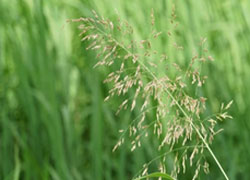
Johnsongrass (prussic acid and nitrate)
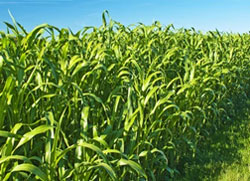
Sudan Grass (prussic acid and nitrate)

Millet (nitrate)
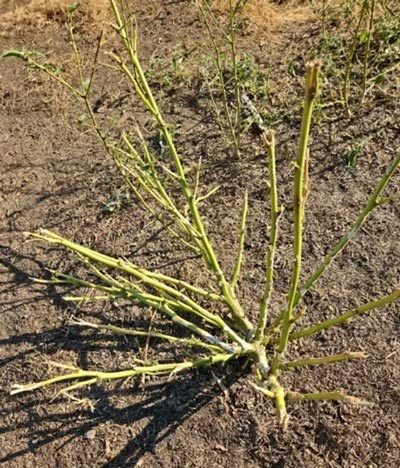
- Johnsongrass (prussic acid and nitrate)
- Corn (nitrate)
- Fescue (nitrate)
- Bermudagrass (nitrate)
- Wild cherry leaves (prussic acid)
- Pigweed (nitrate)
- Brassicas (nitrate)
Recommendations to avoid prussic acid toxicity:
- Avoid grazing when forage is wilted from drought or frost
- Avoid grazing short new regrowth
- Don’t turn hungry animals into a field of stressed or short forage
- Wilted forage is safe to cut and bale for hay – just make sure it is dry
- Scattered patches can be mowed before grazing if the cut forage dries out before turn-in
- Single strand electric fence can be used to keep animals away from sections of fields or fencerows containing suspect plants.
- Avoid grazing stressed forage immediately after a rain – wait 4-5 days before turn-in
Recommendations to avoid nitrate toxicity:
- Apply only low to moderate amounts of N fertilizer or poultry litter to forages associated with nitrate problems (25 lbs N/ton is current recommendation for sorghum/sudan)
- Test suspect forage - field test then lab test
- Don’t turn hungry animals in to suspect fields
- Sometimes, high nitrate concentrations will decline to safe levels with advancing plant maturity, but not always
- If nitrate is high, raise the mowing height for hay
- Nitrate concentration does not decline in hay
- Nitrate concentration can decline by 50% during fermentation in silage/baleage
Since there are no visual signs to clearly indicate that plants are toxic, to further avoid toxicity it is also important to be observant of what your animals are grazing, especially during days with extreme temperatures. If you believe that your hay is undergoing heat stress, it is still possible to bale and check that hay is completely dry before baling.
In addition, it is a good idea to feed your animals before sending them out to pasture because if they are extremely hungry it can increase their risk of exposure to eating heat stressed plants.
What are the signs of prussic acid toxicity?
Signs of toxicity can occur in minutes and mild symptoms include:
- rapid breathing
- gasping
- muscular twitching
- frothy nasal discharge
- tremors
- decreased oxygen utilization leading to mucous membranes appearing bright cherry-red
More severe poisoning can cause animals to experience:
- seizures
- loss of consciousness
- vomiting
- death
It is important to seek veterinary care immediately if poisoning is suspected and to identify the toxin causing the poisoning, as treatment options can vary.
What are the signs of nitrate poisoning toxicity?
Nitrate does not act as quickly as prussic acid, but it only takes hours for symptoms to take effect. The main difference between prussic acid and nitrate toxicity is that animals will show blue mucous membranes and brown discoloration of blood, along with rapid breathing and heart rate.
In severe cases of nitrate toxicity, clinical signs involve weakness, staggering, and death. The best way to diagnose your animals is by using blood tests to measure nitrite levels in the body or test the plants that you suspect your animals consumed for nitrate levels.
Again, it is important to seek veterinary care immediately if poisoning is suspected.
How can I test for prussic acid and nitrates?
The University of Arkansas System Division of Agriculture’s Cooperative Extension Service offers free testing of full forage stems for nitrate presence when brought or shipped to the UADA Department of Animal Science at 2301 South University Avenue, Little Rock, AR 72204.
Visual rating is correlated to the reaction intensity is correlated to the lab analysis. The University of Arkansas Agricultural Diagnostic Laboratory performs nitrate analysis.
For more information, call 479-575-3908 or email agrilab@uark.edu.
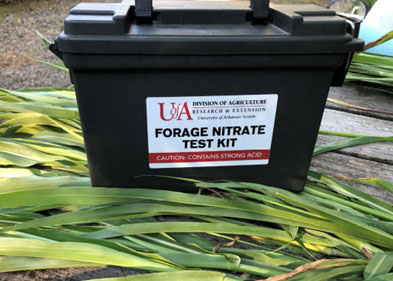
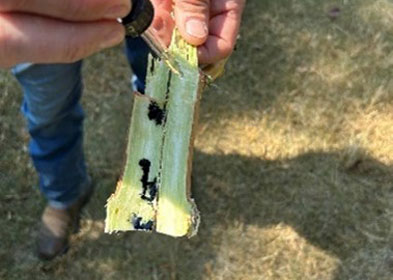
Prussic acid testing is complicated because of volatilization. For prussic acid field testing, you should test leaves. With a bag partially closed, use scissors to cut leaves into pieces; cut a short piece of Cyantesmo test paper and put it inside the bag; close the bag; and read the strip within 5 minutes. Choke cherry is a positive control. Cyantesmo paper has carcinogenic properties, therefore care should be taken when handling. It is recommended that proper eye protection and gloves be worn when handling.
What are the treatments available?
Prussic Acid Toxicity
Prussic acid and cyanide are the same toxic substance; therefore, when treating prussic acid poisoning it is the same as treating cyanide intoxication. The test is a useful tool in early detections of the poisoning, which can result in death or severe neurological damage if not treated promptly. Normally, concentrations below 250-500 ppm are considered safe.
The recommended treatment is a slow intravenous injection of 1% methylene blue. Otherwise, treatments include hydroxocobalamin (vitamin B12), activated charcoal and sodium nitrite/thiosulfate. It is important to follow these recommended doses to effectively treat cyanide poisoning in ruminants and administer under a veterinarian’s supervision, due to differences in doses in large and small ruminants.
Nitrate Toxicity
Treatment for nitrate poisoning involves slow intravenous injection of 1% methylene blue in various fluids.
Testing your animals for nitrate poisoning involves collecting plasma samples, such as ocular fluid or any fetal fluid, and shipping the frozen sample in a plastic or glass container to a local lab. It is also important to test soil and plants for nitrate content. A positive field result indicates that the forage can be unsafe for animal consumption. It is recommended to send forage that tests positive to a lab for more analysis.
With all the biological variation that can exist in both plants and animals, it is obviously difficult to develop specific guidelines that fit all conditions. Safe levels of nitrate are not specifically known for all the various livestock feeding conditions. The guidelines for use of feeds with known nitrate content are in Table 1. Reasonable feeding and care of the animal is assumed. It should be mentioned that drinking water is another potential source of nitrate toxicity.
|
NO3-N (ppm) |
NO3 (ppm) |
Comment |
|---|---|---|
|
<1000 |
<4400 |
Safe. A 150-pound ewe consuming 3 pounds of dry matter would consume about 1.35 grams of NO3-N or less than 1 gram per 100 pounds of body weight. |
|
1000 to 2000 |
4400 to 8800 |
Generally safe for most animals when fed balanced rations. Best to limit it to half of the total dry ration for pregnant animals and also be sure water is low in nitrate. |
|
2000 to 4000 |
8800 to 15000 |
Limit amount to less than half of total ration (dry matter basis). Be sure ration is well fortified with energy, minerals, vitamin A. |
|
Over 4000 |
Over 15000 |
Potentially toxic - do not feed. |
Table 1. Guidelines for use of feed with known nitrate content, expressed by nitrate-N (NO3-N) or nitrate (NO3), dry matter basis. Source: Adapted from Undersander et al. (n.d.)
To prevent nutritional or metabolic disorders associated with long-term excess dietary nitrate consumption, trace mineral supplements and an overall balanced diet are recommended. The feeding of grain with high-nitrate forages may reduce nitrate levels by increasing levels of nitrate-reducing bacteria.
Prussic acid and nitrate intoxication can massively impact livestock and may cause death, so appropriate measures must be taken to prevent it.
Additional resources
- UADA/Forages. Nitrate and Prussic Acid Poisoning in Cattle.
- Cope, R. B. (2023, June 29). Cyanide poisoning in animals - toxicology. Merck Veterinary Manual.
- Gadberry, S., Jennings, J. (n.d.-b). Prussic acid [Factsheet]. University of Arkansas System Division of Agriculture Cooperative.
- Undersander, D. Combs, D., Shaver, R., Schaefer, D. Thomas, D. (n.d.) Nitrate Poisoning in Cattle Sheep and Goats. University of Wisconsin Extension.
- Thompson, L. J. (2023, June 29). Nitrate and nitrite poisoning - special pet topics. Merck Veterinary Manual.